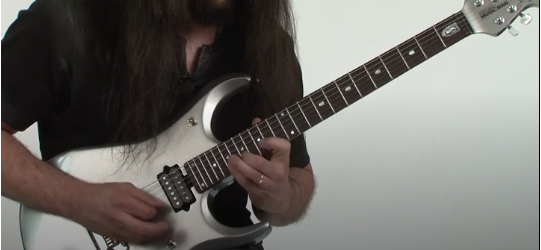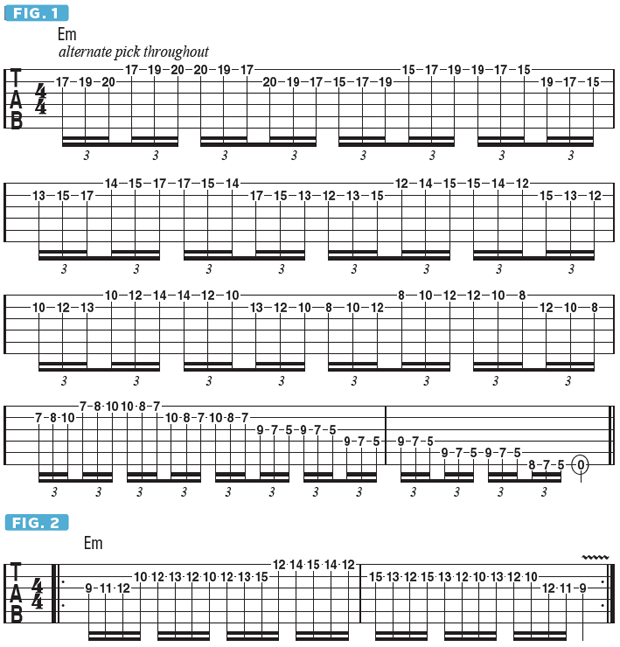Relocating Familiar Scalar Patterns to Different Areas of the Fretboard
John Petrucci teaches you the formation of specific scalar patterns, or “shapes,” and how to connect them while traversing the fretboard.

Let’s continue with a topic that I addressed in last month’s column: focusing on the formation of specific scalar patterns, or “shapes,” and how to connect them while traversing the fretboard.
To me, this concept and approach offer a sensible way to practice these ideas/patterns in order to build up one’s chops while also increasing overall fretboard awareness and mastery of scales.
The thing I like best about the licks I’m going to show you is that they force you to look at the fretboard beyond playing in a fixed position, or “box” pattern, as the runs move in a more diagonal pattern across the fretboard, which is much more in line with the way that I actually approach the instrument in regard to improvisational soloing.
FIGURE 1 illustrates a pattern based on the E Aeolian mode (E F# G A B C D) and is played in steady 16th-note triplets. When ascending and descending, the shapes are created by a three-notes-per-string approach while remaining diatonic to (within the scale structure of) E Aeolian. I alternate pick (down-up) throughout, starting on a downstroke.
This exercise provides a great workout for both hands, in that the fret-hand fingerings change often, from index-middle-pinkie to index-ring-pinkie, and it requires a good amount of stamina and accuracy to alternate pick every note in this five-bar run with absolute precision and clarity.
I recommend that you practice it as slowly as possible at first, with strict attention paid to clear articulation of every note while striving to keep both hands as relaxed as possible. Then, gradually increase the tempo. Try to keep your fret-hand fingers arched over the strings, positioned so that the fingertips are coming down onto the board from directly above, as this will help you attain a sharper, more defined note.
Throughout the first three bars and through beats one and two of bar 4, the pattern that ascends on beats one and three is repeated in reverse, in descending order, on beats two and four. Spending a little extra time like this on each pattern/shape should facilitate the memorization of the pattern as well as provide an extra workout designed to bolster your technique. Because the patterns are played in reverse order on every other beat, the highest note is always repeated on the downbeat.
I like to accent these high notes the second time through by picking them a little harder, which serves to add rhythmic drive to the phrase. At the end of the pattern, beginning on beat three of bar 4, I repeatedly descend through a new pattern, one built from the repetition of the previous three-note melodic shape.
Now let’s take a similar idea and apply it to straight 16th notes. In FIGURE 2, I play lines based on eight-note patterns in E Aeolian that ascend through the scale one degree at a time in that I follow the last note of each eight-note “cell” by moving up to the next scale degree and starting a new cell.
In FIGURE 3 I apply the same idea to the 16th-note-triplet rhythm shown initially in FIGURE 1. Once you have a firm grasp of these patterns, try playing them in every area of the fretboard and on every group of strings that you can think of. If you then expand the exercise to other scales and modes, you will have many hours of dedicated, worthwhile practice ahead of you!


Get The Pick Newsletter
All the latest guitar news, interviews, lessons, reviews, deals and more, direct to your inbox!









![Joe Bonamassa [left] wears a deep blue suit and polka-dotted shirt and plays his green refin Strat; the late Irish blues legend Rory Gallagher [right] screams and inflicts some punishment on his heavily worn number one Stratocaster.](https://cdn.mos.cms.futurecdn.net/cw28h7UBcTVfTLs7p7eiLe.jpg)
